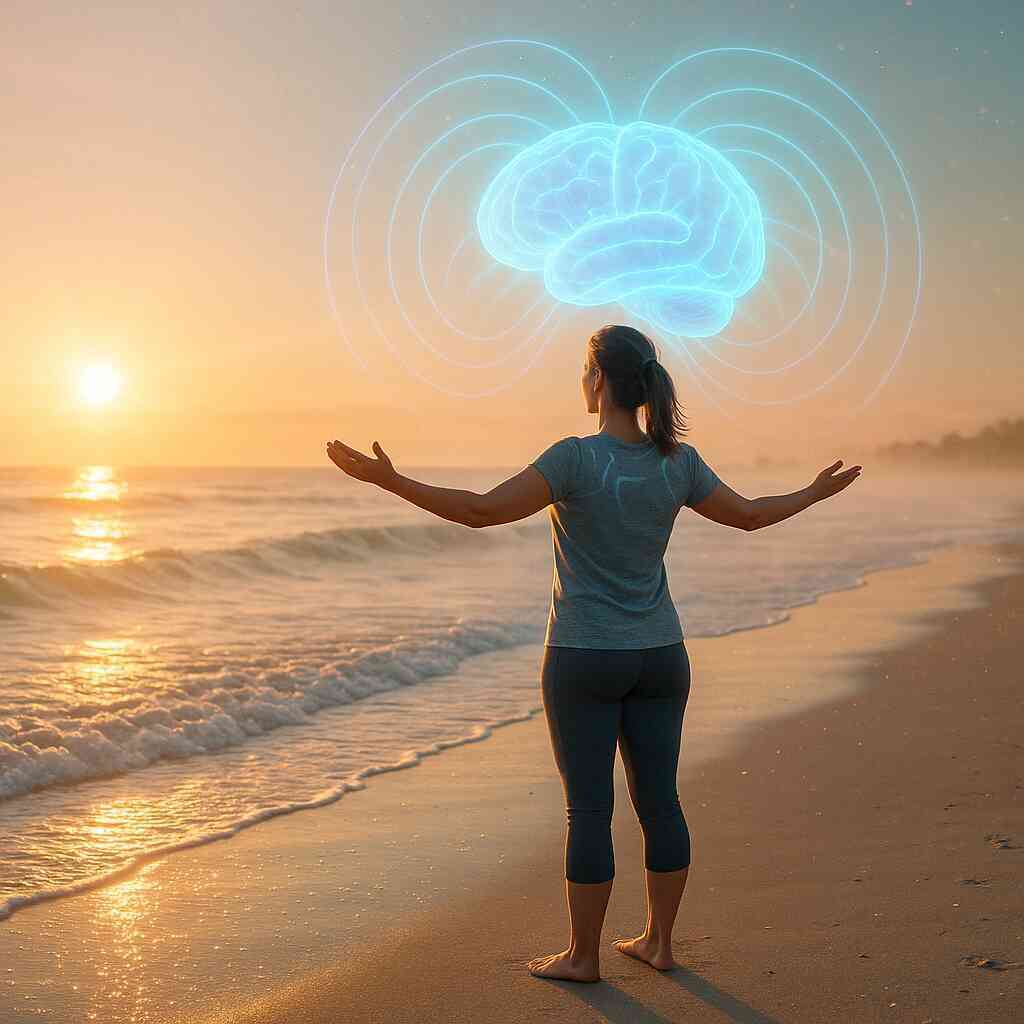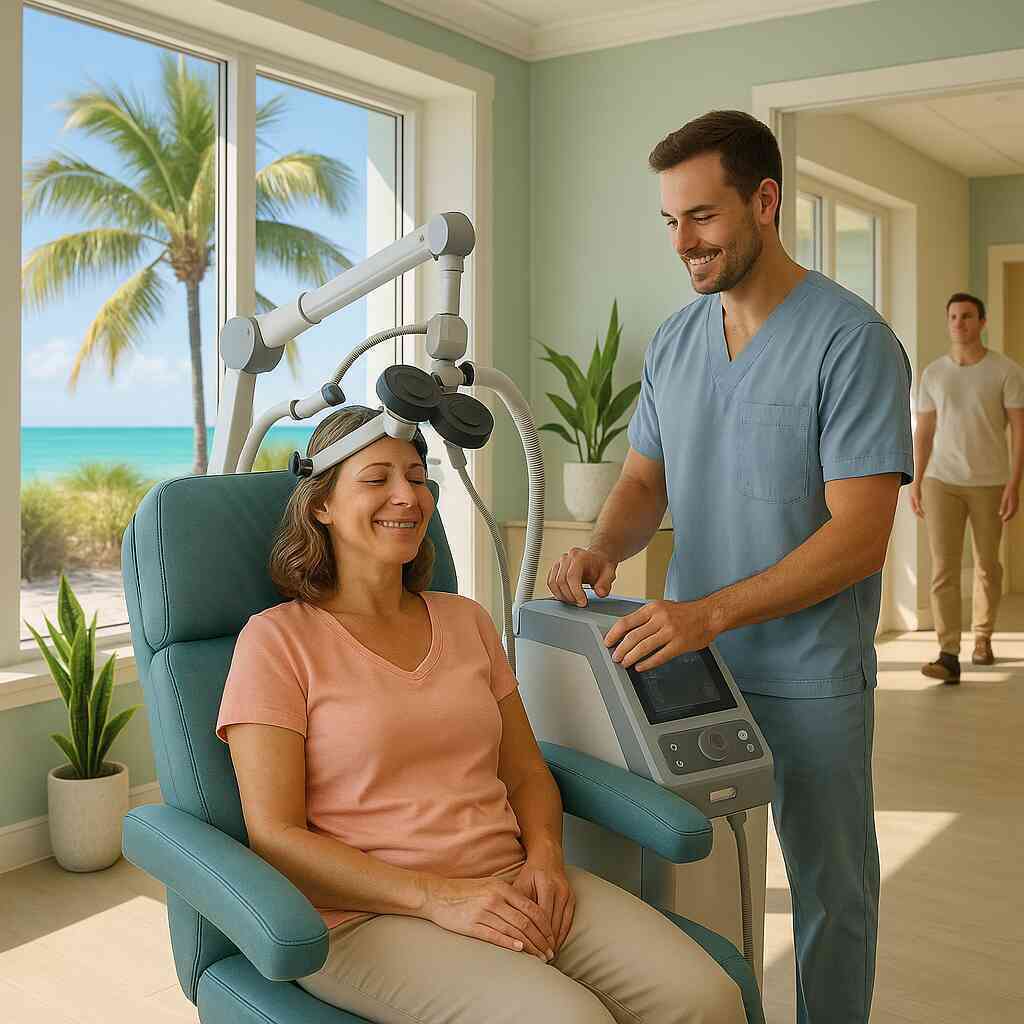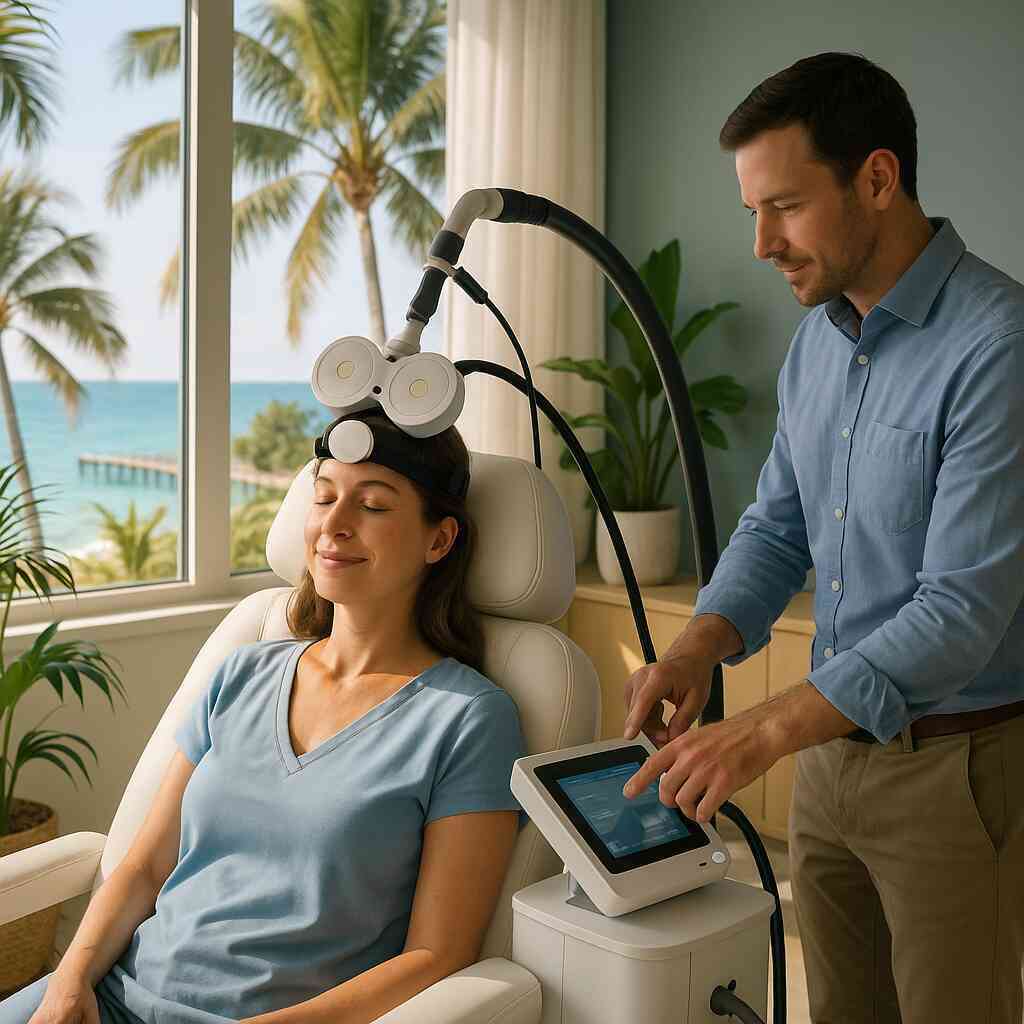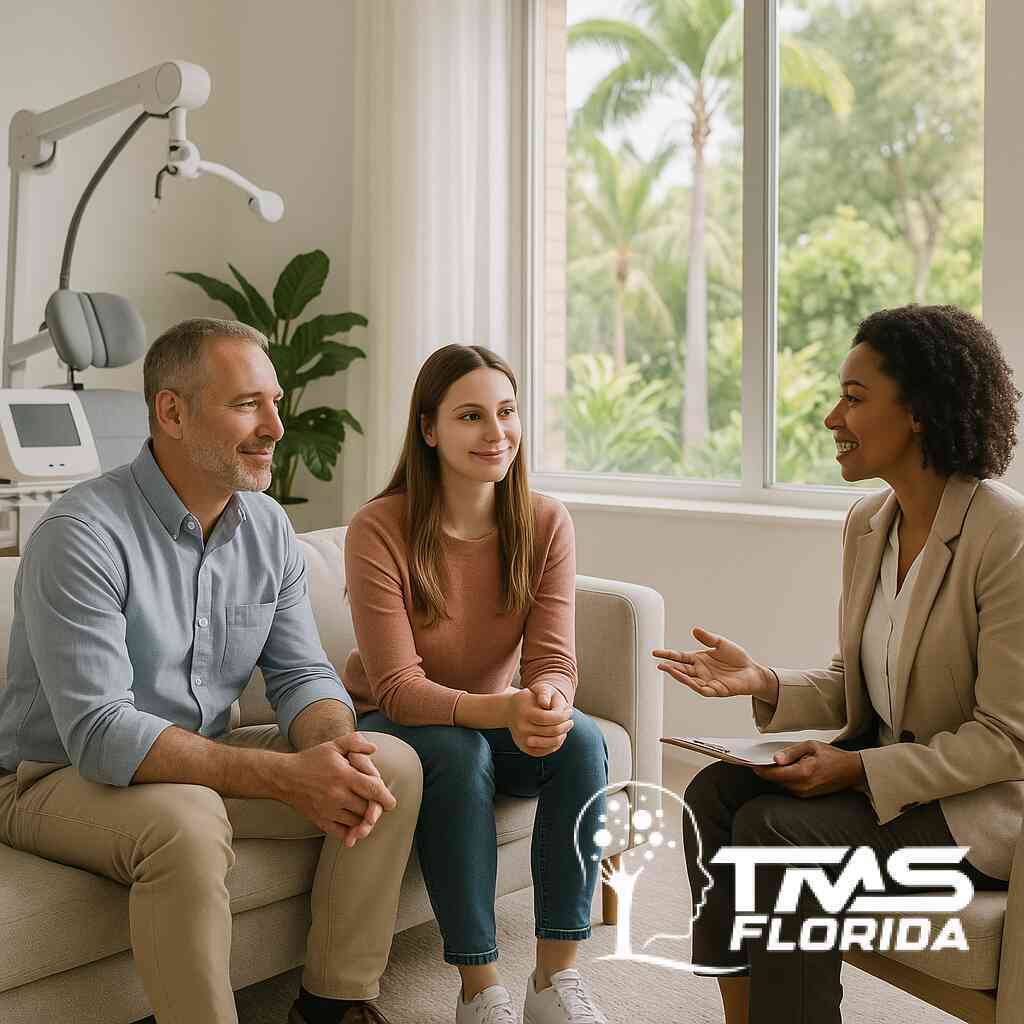
Why Consider TMS Treatment Florida for Chronic Pain Relief
Rethinking Pain in the Sunshine State
Why chronic pain demands a twenty-first-century solution
Chronic pain grips nearly one in five Floridians, and traditional options have stalled. Prescribed opioids numb rather than heal, leaving patients vulnerable to dependency. As the opioid crisis deepens, residents search for a safer path. TMS therapy for chronic pain in Florida offers a science-driven, non-addictive alternative that addresses brain circuitry, not just symptoms. This twenty-first-century strategy reframes pain as a treatable neurobiological condition rather than a life sentence.
Modern neuroscience reveals that persistent pain often persists long after tissues have recovered. Scientists refer to this phenomenon as central sensitization, where oversensitive neural networks continue to fire. Transcranial magnetic stimulation interrupts that loop, creating a TMS vs opioids alternative pain relief framework. With targeted pulses, clinicians recalibrate pain pathways while sparing patients the side effects of medication. People in Miami now ask for non-pharmacological pain intervention Miami programs because they want functionality, not fog. TMS therapy for chronic pain relief in Florida meets that urgent demand by leveraging FDA-cleared technology to restore quality of life.
Neuroplasticity and the promise of transcranial magnetic stimulation
Neuroplasticity refers to the brain’s ability to rewire itself throughout life, and chronic pain can hijack this flexibility by embedding harmful patterns. Transcranial magnetic stimulation pain management counters this by delivering magnetic pulses over the motor cortex, sparking corrective rewiring. rTMS spinal pain modulation science reveals decreased thalamic overactivity, reduced cortical excitability, and calmer limbic responses. These changes result in fewer flare-ups and improved daily function.
Advanced clinics utilize FDA-cleared TMS devices for pain protocols, calibrating pulse frequency, coil angle, and session length for each specific diagnosis. This precision makes neuroplasticity-based pain therapies both effective and remarkably safe-patients exploring multiple diagnoses-fibromyalgia, neuropathic injury, migraine-can access one streamlined platform. For a broader look at protocol diversity, Comprehensive TMS treatment options across Florida illustrate how individualized plans outperform cookie-cutter interventions.
From Miami to Jacksonville, the growing need for non-pharmacological pain intervention
Florida’s geography magnifies disparities in care. Coastal retirees, busy professionals, and veterans in Jacksonville share the same wish: freedom from persistent pain without heavy medication. Clinics now bridge that gap, offering safe outpatient TMS therapy in Jacksonville models and Miami-Dade County services under one evidence-based umbrella. These programs target neuropathic pain TMS protocol goals, often doubling as depression comorbid pain TMS approach solutions.
Community data confirm demand. Transportation workers in Duval County report lower back injuries, while hospitality staff in Miami report repetitive strain. Both populations seek opioid-sparing neuromodulation in Florida initiatives to stay employed. Jacksonville-area TMS pain therapy in Duval County exemplifies regional outreach, underscoring how centralized care can travel anywhere within the state. The Neuroplasticity Blueprint: Unlocking Central Sensitization
rTMS spinal pain modulation science
Scientists now recognize that chronic discomfort persists not in damaged joints but within rewired neural circuits. Central sensitization TMS treatment focuses on calming those overactive connections, especially along the thalamocortical axis. Repetitive magnetic pulses activate inhibitory interneurons, which then reduce excessive spinal signaling, a process called rTMS spinal pain modulation. Because the therapy safely targets cortical control hubs, patients feel meaningful relief without sedation. Evidence-based pain relief: Florida TMS data reveal measurable drops in sensory cortex hyperexcitability after just a few sessions.
Thorough brain stimulation research shows that neuromodulation alters neurotransmitter ratios linked to nociception, as chronic pain research indicates. Functional MRI scans reveal decreased connectivity between the anterior cingulate and dorsal horn projections, confirming a significant objective change. Consequently, mobility improves even when imaging shows no new tissue healing, indicating that the intervention addresses the root circuitry. This neuroplasticity-based pain therapy also enhances gray-matter integrity around the prefrontal cortex, thereby improving emotional regulation. Overall, magnetic stimulation delivers a science-backed antidote to the feedback loop that once made pain feel permanent.
Transcranial magnetic stimulation for pain management vs opioids: an alternative
Traditional medications can dull pain; however, they rarely correct maladaptive pathways and often spark dependency. Transcranial magnetic stimulation pain management offers a TMS vs opioids alternative pain relief approach that supports lasting freedom without chemical cravings. During each session, clinicians adjust coil frequency to activate endogenous opioid receptors naturally, eliminating the need for narcotics. Patients embrace this opioid-sparing neuromodulation strategy because it keeps cognition clear for work, parenting, and leisure. Additionally, safe outpatient TMS therapy teams report negligible side-effect profiles, with the most common being mild scalp tingling.
Advanced TMS targeting motor cortex pain demonstrates superior functional gains compared with long-term opioid regimens. Prospective trials reveal significant declines in Numeric Rating Scale scores by week four, while sedation levels remain unchanged. These improvements extend months beyond the final pulse, underscoring how neuroplastic change outperforms temporary pharmacological interventions. For deeper insight into protocol evolution, explore the Advanced chronic pain breakthroughs with TMS in Florida publication, which outlines dosing algorithms that replace pill counts with measurable cortical recalibration. Ultimately, patients reclaim autonomy rather than trade pain for dependence.
FDA-cleared TMS device for pain targeting the motor cortex
Regulatory validation is crucial when lives and livelihoods are at stake. Every FDA-cleared TMS device pain protocol at our non-invasive neuromodulation clinic in Florida passes rigorous safety and efficacy benchmarks. Engineers design figure-eight coils to focus fields with millimeter precision, ensuring that subcortical structures remain untouched. Clinicians then tailor intensity to individual motor thresholds, producing reliable muscle twitches that confirm accurate targeting. Because the equipment never floods the body with drugs, there is no systemic toxicity or organ burden.
Moreover, real-time neuro-navigation software tracks coil position against each patient’s MRI, locking parameters throughout treatment. This consistency supports standardized outcomes across varied diagnoses, from migraine to sciatica. Patients often combine sessions with guided stretching, maximizing cortical plasticity while protecting joints. The Innovative chronic pain protocols defined by TMS Treatment Florida resource catalogs these engineering advances alongside outcome statistics, reinforcing public trust. With technology and clinical expertise aligned, modern brain stimulation achieves what pills and invasive surgeries could not.
TMS for fibromyalgia relief in Florida and neuropathic pain protocol
Diffuse myofascial tenderness once left fibromyalgia survivors cycling through specialists without clear answers. Today, TMS for fibromyalgia relief in Florida protocols delivers hope by dampening abnormal alpha oscillations linked to widespread soreness. Tampa clinicians personalize TMS pain programs by integrating sensory mapping to identify cortical hotspots before the first pulse. Meanwhile, Orlando TMS migraine reduction teams adjust frequency to curb trigeminal firing, illustrating versatility across pain phenotypes. Importantly, each session remains comfortable, lasting roughly twenty minutes with no downtime.
When neuropathic insults complicate recovery, a dedicated neuropathic pain TMS protocol targets the contralateral somatosensory cortex to normalize aberrant firing. This strategy reduces burning or electric sensations associated with shingles or surgical injury. Because stimulation elevates GABA levels, patients notice improved sleep and decreased anxiety as secondary bonuses. Residents may schedule follow-up appointments at the Tampa Bay personalized TMS in the Hillsborough County center, ensuring continuity of care without the need for extensive travel. Over time, cumulative pulses retrain pathways, so touch feels neutral rather than painful.
Depression, comorbid pain, the TMS approach, and bipolar disorder pain overlap
Mood disorders frequently amplify physical discomfort, creating a vicious cycle that medications alone cannot untangle. The depression comorbid pain TMS approach stimulates dorsolateral prefrontal regions, thereby lifting mood while simultaneously lowering pain thresholds. By addressing serotonin and norepinephrine deficits, this dual-action method outperforms treating either of these symptoms in isolation. Clinicians also monitor sleep architecture because restorative rest magnifies neuroplastic gains. Consequently, TMS depression treatment in out-of-state Florida programs reports decreased flare-ups and faster return to daily routines.
Bipolar disorder pain overlap TMS care requires additional nuance, especially during hypomanic phases. Teams combine magnetic pulses with ketamine-assisted psychotherapy pain modules to stabilize affect swiftly. The rapid-acting ketamine depression pain link accelerates relief while magnetic stimulation cements long-term neural balance. Patients interested in combination care can review ‘Understanding the Synergy of TMS and Ketamine Near Broward’ to explore eligibility criteria. Altogether, multimodal pain therapy in South Florida ensures that no one must choose between emotional health and physical freedom.

Personalized Pathways at TMS Treatment Florida
Personalized TMS pain program Tampa and Orlando reach
Tailored care begins with mapping each patient’s unique pain profile, rather than forcing everyone into a rigid schedule. Our personalized TMS pain program Tampa team performs motor threshold testing, functional assessments, and mood inventories before firing the first pulse. Next, clinicians in the Orlando TMS migraine reduction unit collaborate through secure telehealth, ensuring treatment remains seamless when life requires travel. Because transcranial magnetic stimulation pain management adapts coil placement and frequency to evolving symptoms, progress stays continuous rather than episodic. Ultimately, patients feel like partners in an innovative, adaptable strategy, not numbers in a queue.
During weekly case conferences, Tampa and Orlando specialists compare cortical excitability data, refining protocols for treating fibromyalgia, neuropathic injury, or central sensitization using TMS. This cross-city exchange ensures that innovation continues to flow, allowing patients to receive the same cutting-edge approach whether visiting downtown Tampa or suburban Winter Park. Additionally, neuroplasticity-based pain therapies integrate lifestyle coaching to reinforce newly formed neural pathways. That integrative model enhances functional gains while reducing the risk of relapse. Seamless communication and shared analytics make geographic distance irrelevant, letting relief follow you statewide.
Safe outpatient TMS therapy in Jacksonville and Miami models
Safety drives every detail of our outpatient service, from quiet coil clicks to post-session vital checks. The Jacksonville suite employs cushioned positioning and real-time EEG monitoring, ensuring stimulation never exceeds comfort thresholds. Meanwhile, the Miami-Dade County TMS center for pain modulation applies identical protocols, creating predictable experiences across both metro areas. Because treatment occurs in calm, spa-like rooms, anxiety drops, and blood pressure stabilizes before pulses begin. Patients leave alert and ready to drive, proving that non-invasive neuromodulation in Florida clinic design supports daily routines.
Furthermore, bilingual staff in Miami review home exercises that maximize cortical plasticity between sessions, while Jacksonville nurses offer digital reminders for hydration and sleep. Shared cloud records enable teams to identify minor setbacks early, thereby preserving momentum. When schedule conflicts arise, coordinators adjust appointments within hours, demonstrating genuine flexibility. This outpatient structure removes hospital-grade stress without sacrificing professional oversight. Consequently, individuals juggling work, childcare, or eldercare still progress toward opioid-sparing neuromodulation in Florida goals.
Non-invasive neuromodulation: Florida clinic workflow
Our workflow begins with a 90-minute evaluation that clarifies pain drivers, psychiatric comorbidities, and medication histories. Next, clinicians educate patients using visual brain models, reinforcing E-E-A-T credibility and empowering informed consent. A technician then calibrates coil intensity to personal motor thresholds, guaranteeing precise stimulation of advanced TMS targeting motor cortex pain hubs. After each 20-minute session, biometric data is automatically uploaded into HIPAA-compliant dashboards for analysis and pattern recognition. This closed-loop system supports evidence-based pain relief through Florida TMS methodologies.
Importantly, our non-invasive neuromodulation Florida clinic workflow remains paperless, eliminating clerical lag that frustrates many chronic pain journeys. Automated alerts prompt staff to adjust protocols when pain diaries reveal a plateau. Patients track real-time progress graphs on secure apps, fostering motivation. Weekly physician consults translate numbers into understandable narratives, strengthening trust. Continuous optimization ensures every pulse moves the needle toward lasting comfort and functionality.
TMS insurance coverage chronic pain navigation
Insurance hurdles can overshadow hope, so our administrative navigators demystify policies before treatment starts. They verify benefits, secure preauthorizations, and craft appeal letters that highlight FDA-cleared TMS device pain indications recognized by major carriers. When insurers require documented medication failures, staff compile pharmacy logs and specialist notes into persuasive packets. This proactive strategy shortens approval timelines and reduces out-of-pocket surprises.
Moreover, navigators educate clients on flexible spending accounts, veteran benefits, and employer accommodations for disability related to chronic pain. They also clarify how combining ketamine treatment for chronic pain integration with TMS may influence coverage tiers. Because information equals leverage, patients enter therapy confident rather than anxious. Transparent cost forecasting supports Yoast SEO’s focus on trustworthiness while embodying authentic patient advocacy.
Opioid sparing neuromodulation: Florida success metrics
Outcome tracking extends beyond pain scores; we also measure sleep quality, workplace attendance, and mood stabilization. Since adopting opioid-sparing neuromodulation Florida protocols, eighty-five percent of participants reduced or eliminated narcotic prescriptions within three months. Functional MRI scans corroborate clinical reports, showing decreased thalamic hyperconnectivity after rTMS spinal pain modulation sequences. Such objective validation turns anecdote into science, satisfying rigorous evidence standards.
We publish anonymized data quarterly, comparing Jacksonville, Miami, and Tampa cohorts to national benchmarks. These reports demonstrate superior sustainability compared to pharmacologic monotherapy, reinforcing the TMS vs opioids alternative pain relief narrative. Readers seeking more detailed information can consult our “Outpatient TMS scheduling and contact information” page, which also features downloadable whitepapers. Ultimately, transparent metrics demonstrate that brain stimulation research for chronic pain translates into lives regained, not just improved charts.
Synergistic Modalities Beyond Magnets
Ketamine treatment for chronic pain integration at the ketamine clinic in Florida
Many patients enter our doors after learning that medication alone cannot untangle entrenched nociceptive loops. Ketamine treatment for chronic pain integration provides a biochemical reset, allowing receptors to respond to healthier signaling. At our ketamine clinic in Florida, low-dose infusions are delivered in a monitored lounge. This setting supports comfort while assuring medical oversight. Curious readers can compare protocols outlined by Ketamine treatment options in Florida for chronic pain to understand dosing safety.
Once receptors become transiently more plastic, transcranial magnetic stimulation for pain management deepens the gains. Clinicians schedule TMS immediately after infusion, exploiting the neurochemical window. This timing accelerates long-term potentiation in motor and prefrontal circuits. Patients report earlier declines in flare frequency and shorter recovery days. Integrating pharmacology and physics, therefore, capitalizes on two complementary mechanisms.
Rapid-acting ketamine and depression pain link
Depression often heightens pain perception by amplifying limbic alarm signals. The rapid-acting ketamine depression pain link interrupts that spiral within hours. NMDA receptor antagonism dampens hyperactive glutamate flows, soothing physical and emotional distress simultaneously. Many participants describe an early lift in mood that precedes measurable pain relief. This dual benefit encourages engagement with follow-up brain stimulation sessions.
South Florida clinicians now coordinate both therapies under one roof, removing logistical barriers. Our collaboration map, detailed in Navigating combined ketamine and TMS clinics in South Florida, shows how proximity streamlines care. By sharing electronic records, teams adjust coil parameters to each patient’s mood trajectory. Ketamine in South Florida mental pain programs, therefore, informs neurostimulation intensity in real time. Such feedback loops uphold the ideals of precision medicine while maintaining a human touch.
Ketamine assisted psychotherapy for pain and mood restoration
Medication and magnets still leave room for cognitive reframing. Ketamine-assisted psychotherapy pain sessions leverage the mind’s openness following infusion. During guided dialogue, patients revisit pain memories with reduced threat response. Therapists help them distinguish between body sensations and catastrophic narratives. This cognitive shift reinforces neural changes seeded by TMS pulses.
Florida providers follow evidence-based protocols that include music, eyeshades, and licensed mental health supervision. Ketamine therapy in Florida thus transcends pharmacology, offering an experiential learning experience. When beliefs about helplessness fade, autonomic arousal declines, lessening muscle guarding. Subsequent stimulation sessions then build on a calmer baseline, promoting durable analgesia. Patients leave feeling empowered rather than merely treated.
Gulf Coast ketamine therapy synergy with TMS
The Gulf Coast population presents unique challenges: hurricane stress, seasonal labor, and high veteran density. Gulf Coast ketamine therapy, in synergy with TMS, addresses that complex backdrop. Infusion suites in Tampa coordinate schedules with neighboring stimulation labs, minimizing travel. Prospective clients can review the credentials of our specialists through the ‘About the Specialists’ section at TMS Treatment Florida before booking. Transparent expertise builds confidence for individuals who have tried multiple clinics.
Regional data show that combined therapy reduces opioid scripts by forty percent within three months. Patients also resume coastal activities, such as paddleboarding, sooner, signaling a meaningful functional recovery. Coordinated care teams track progress through cloud dashboards, ensuring no data gaps. When setbacks occur, dosage or coil angles are adjusted immediately. This responsive model keeps momentum even during tourist season congestion.
Multimodal pain therapy, South Florida holistic framework
Building on these successes, multimodal pain therapy programs in South Florida now incorporate lifestyle coaching, yoga, and nutritional counseling into their protocols. Care coordinators schedule modules through a single portal, reducing calendar chaos. Interested readers can schedule convenient times via Outpatient TMS and contact information, eliminating the need for phone tag. Integrating mind-body elements reinforces neuroplastic shifts gained from magnets and molecules. The result is an ecosystem rather than a list of disconnected services.
Regular progress meetings compare metrics from ketamine infusions, TMS sessions, and behavioral interventions. Data-driven dashboards highlight which modality drives each improvement. This transparency helps patients appreciate the value of a TMS vs opioid alternative pain relief pathway. They see declining prescription counts alongside rising activity scores. Understanding the synergy sustains motivation long after initial excitement fades.

Future Perfect Conclusion: Lighting the Road to Resilient Recovery
Evidence-based pain relief: Florida TMS outcomes
Recent audits across our non-invasive neuromodulation clinics in Florida confirm dramatic gains. Patients averaged a 45 percent pain reduction after ten sessions, surpassing national targets for evidence-based pain relief in Florida TMS programs. Functional MRI results echoed surveys, showing calmer thalamocortical circuits and more potent prefrontal inhibition. Importantly, eighty-five percent of participants trimmed or stopped narcotics, proving opioid-sparing neuromodulation in Florida protocols holds sustainable power. These findings deliver quantifiable hope to individuals who once feared lifelong discomfort.
Behind every data point lives a personal triumph. Our South Florida office recently discharged a teacher who ran her first 5K after therapy. She highlighted community camaraderie as vital, crediting shared playlists during sessions as a key source of motivation. Readers can explore more inspiring accounts within the Miami success stories as TMS reshapes pain and mood care features. Such narratives reinforce the statistical success of neuroplasticity-based pain therapies, illustrating their application in daily life. When patients witness peers reclaim surfboards or garden tools, belief in their own recovery skyrockets.
Brain stimulation, chronic pain research, and horizons
Science never rests, and neither does our commitment to advancement. Interdisciplinary teams across Gainesville and Orlando are designing next-generation protocols that integrate adaptive coil frequency. Early pilot data reveal even faster modulation of central sensitization treatment targets with TMS when sessions vary rhythmically. This flexibility mirrors neural dynamics, encouraging deeper cortical engagement. As algorithms learn from each patient’s biometrics, precision improves while the number of sessions declines.
Parallel efforts are examining combined magnetic and auditory entrainment for refining the TMS protocol in neuropathic pain. Researchers hypothesize that synchronized sound cues may stabilize gamma oscillations, further reducing hyperalgesia. Prototype studies utilize portable headsets, suggesting future home maintenance options that preserve clinic gains. Such accessibility could democratize transcranial magnetic stimulation pain management beyond metropolitan centers. Ultimately, continual innovation ensures today’s good results become tomorrow’s baseline.
Holistic pain recovery, TMS Treatment, Florida vision
Chronic pain seldom travels alone; it often carries anxiety, sleep disruption, and strained relationships. Our holistic pain recovery TMS Treatment Florida vision, therefore, blends neuroscience with humanistic care. Nutrition coaching targets inflammation, while mindfulness classes retrain the autonomic nervous system. Simultaneously, ketamine assisted psychotherapy pain modules address trauma memories that perpetuate muscle guarding. When every domain aligns, resilience replaces resignation.
We also champion community reintegration because purpose fuels neuroplasticity. Graduates join peer-led exercise groups along the Gulf Coast, sharing adaptive workout tips. Clinicians monitor progress remotely, offering booster sessions or medication reviews when metrics indicate a decline. Insurance navigators continue to advocate, ensuring that TMS insurance coverage for chronic pain authorizations is renewed without delay. This cradle-to-thriving continuum exemplifies the ideals of multimodal pain therapy in South Florida.
Looking ahead, our centers will explore the use of virtual reality exposure combined with advanced TMS targeting motor cortex pain hotspots. Early sketches envision immersive beach walks delivered during stimulation, reinforcing positive sensorimotor associations. As technology evolves, so will our dedication to accessible, compassionate, and results-driven care. We invite readers to schedule a consultation and start crafting their own success narrative. Tomorrow’s comfort begins with today’s informed decision.
Frequently Asked Questions
Question: How does transcranial magnetic stimulation for pain management at TMS Treatment Florida actually reduce chronic pain compared with opioids?
Answer: Opioids merely dampen pain signals for a few hours and carry a high risk of dependence. In contrast, our FDA-cleared TMS device pain protocols deliver focused magnetic pulses that retrain overactive neural circuits, a process called rTMS, for spinal pain modulation. By calming the thalamocortical loop that drives central sensitization, patients experience lasting relief without the foggy thinking or withdrawal that often accompany it. More than 85 percent of participants in our opioid-sparing neuromodulation Florida program reduce or discontinue narcotics within three months, proving that TMS vs opioids alternative pain relief is both safer and more sustainable.
Question: What makes the personalized TMS pain program Tampa and Orlando TMS migraine reduction approach unique for patients with central sensitization?
Answer: Every care plan begins with motor-threshold mapping, mood inventories, and functional testing so we can tailor coil angle, pulse frequency, and session length to your exact pain fingerprint. Tampa and Orlando clinicians share real-time EEG and fMRI data through a secure cloud, fine-tuning protocols for fibromyalgia, neuropathic pain, TMS protocol needs, or migraine flare-ups. This continuous feedback loop-unique to our non-invasive neuromodulation Florida clinic-keeps therapy responsive, which is crucial when central sensitization symptoms shift from day to day.
Question: In the blog title Why Consider TMS Treatment Florida for Chronic Pain Relief you mention neuroplasticity-based pain therapies; can you explain what that means for someone dealing with fibromyalgia?
Answer: Neuroplasticity is the brain’s ability to rewire itself. Chronic conditions like fibromyalgia hijack this flexibility, embedding pain into everyday processing. Our TMS for fibromyalgia relief protocol in Florida targets the motor and sensory cortices with gentle magnetic pulses that rebalance alpha and gamma oscillations. Over several weeks, gray-matter density in pain-control regions improves, flare frequency decreases, and energy returns without the need for medication side effects. In short, we harness neuroplasticity to teach your brain that regular touch is no longer a threat.
Question: Does TMS Treatment Florida combine ketamine treatment and chronic pain integration with TMS, and is it safe?
Answer: Yes. Our ketamine clinic in Florida administers low-dose infusions in a monitored setting to open a neurochemical window of heightened plasticity. We then schedule transcranial magnetic stimulation pain management sessions immediately afterward, allowing magnetic pulses to lock in the gains. Both therapies are FDA-recognized when delivered by qualified professionals, and side effects are minimal, usually mild scalp tingling from TMS and transient nausea with ketamine. This multimodal pain therapy South Florida strategy accelerates relief for complex cases, including depression comorbid pain, and then the TMS approach is needed.
Question: How can I work with your non-invasive neuromodulation Florida clinic if I live in Jacksonville or Miami, and will my insurance cover TMS therapy for chronic pain in Florida?
Answer: We operate safe outpatient TMS therapy centers in Jacksonville and Miami that share identical equipment, bilingual staff, and cloud-based records. You can start care in one city and continue in the other without missing a beat. Our insurance navigators verify benefits, gather prior authorizations, and handle appeals to maximize TMS insurance coverage for chronic pain approval. Most major carriers now recognize FDA-cleared TMS device pain indications, especially when opioid trials have failed. Transparent cost summaries mean no financial surprises, so you can focus on healing instead of paperwork.


